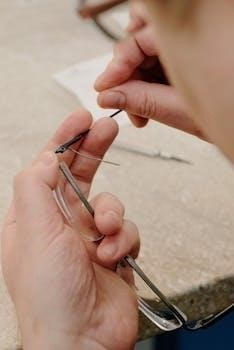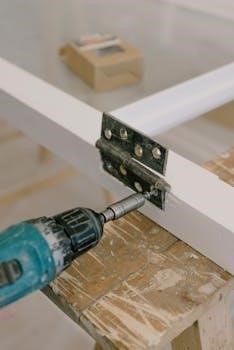
Common KitchenAid Mixer Issues
KitchenAid mixers, while reliable, can encounter issues. These can include the mixer failing to turn on, often due to power problems or motor malfunctions. Another common concern is overheating, which can cause the mixer to shut down.
Mixer Not Turning On
If your KitchenAid mixer refuses to start, the first step is to verify that it’s properly plugged into a functioning electrical outlet. Test the outlet by plugging in another appliance to confirm it’s working. Check your home’s circuit breaker to ensure it hasn’t tripped. A loose power cord can also be the culprit, so inspect it for any damage or poor connections. Sometimes, the internal wiring within the mixer itself may have issues. It’s also possible that the motor has failed, or that there are control problems within the mixer’s electronics. If the outlet and cord are fine, the mixer might have overheated and shut down automatically. Let it rest for approximately 30 minutes before attempting to turn it on again. A worn-out or broken wire inside the mixer could also prevent it from powering up. If after checking all these points, the mixer still doesn’t turn on, further troubleshooting is needed.
Mixer Overheating
KitchenAid mixers, especially when used for extended periods or with heavy loads, can sometimes overheat. When a mixer overheats, it may automatically turn off to prevent damage. If your mixer stops working unexpectedly, it’s advisable to let it cool down for about 30 minutes. This allows the internal components to reach a safe operating temperature. Overloading the mixer with too much dough or other dense ingredients is a frequent cause of overheating. Ensure that you do not exceed the recommended capacities for your mixer model. Insufficient lubrication can also lead to excessive friction and heat generation. If the overheating issue persists even with appropriate usage and rest periods, there could be more severe underlying problems, such as a failing motor or problems with the internal electrical components. In such cases, further investigation and potential repairs are necessary to ensure optimal performance and prevent more extensive damage.

Troubleshooting Steps

When your KitchenAid mixer malfunctions, begin by checking the power supply. Ensure it’s properly plugged into a working outlet. If the issue persists, try resetting the mixer. This can resolve many minor electrical problems.
Checking Power Supply
If your KitchenAid mixer isn’t turning on, the first step in troubleshooting is to meticulously examine the power supply. Begin by verifying that the mixer is securely plugged into a functioning electrical outlet. It’s a simple step, but often overlooked. Don’t just glance at it; make sure the plug is fully inserted and not loose. Next, test the outlet itself. You can do this by plugging in another appliance, like a lamp or a phone charger, to confirm that the outlet is indeed providing power. If the other device doesn’t work either, the issue may lie with your home’s electrical circuit. Check your circuit breaker panel to see if a breaker has tripped and if so, reset it. If the outlet works with other devices, the problem is likely with the mixer’s cord, plug, or internal components, rather than the power source. A damaged cord or plug can be a common culprit, and should be visually inspected for any signs of wear, fraying, or damage.
Resetting the Mixer
If you’ve confirmed that the power supply is not the problem, the next troubleshooting step is to try resetting your KitchenAid mixer. Many KitchenAid models have a thermal overload protector that can trip if the mixer overheats, causing it to stop working. To reset the mixer, first, unplug it from the power outlet. It’s essential to disconnect the mixer entirely to allow the internal components to cool down and for the reset mechanism to engage. Leave the mixer unplugged for approximately 30 minutes to allow sufficient time for the thermal overload protector to reset. After this waiting period, plug the mixer back into the outlet and attempt to turn it on. If the mixer now starts, the issue may have been a temporary overload, but if it continues not to work, consider other problems. If the mixer still does not turn on, it may indicate a more serious issue, requiring further investigation or professional repair.

Repairing Specific Problems
Several specific issues might require repair. Beater misalignment is a common problem, often needing a simple adjustment. Gearbox oil leaks can also occur, necessitating a more involved repair or replacement of seals.
Beater Alignment Adjustment
One of the most frequent issues with KitchenAid mixers is beater misalignment. This problem manifests when the beater doesn’t properly reach the bottom of the bowl, leaving ingredients unmixed, or when it hits the bowl causing a scraping noise. Correcting this is usually straightforward and can be accomplished at home. Start by unplugging your mixer from the power source for safety. You will typically need a flat-head screwdriver to adjust the height of the beater shaft. Locate the adjustment screw, often found near the mixer’s head. Carefully turn the screw clockwise to lower the beater or counter-clockwise to raise it. It’s crucial to make small adjustments and test the beater’s position after each change by using a dime placed in the bowl. The beater should just barely touch the dime without lifting it. If the beater is too low, it will scrape, and if it’s too high, it will not mix properly. Be precise and patient during this process. Once the adjustment is perfect, you will find that your mixer works more efficiently and produces better results. Misaligned beaters can lead to uneven mixing and can even damage the bowl or the mixer itself if left uncorrected.
Gearbox Oil Leak Repair
A gearbox oil leak in a KitchenAid mixer is a sign that the internal grease has likely degraded and is seeping out. This is not an uncommon issue, especially in older models, and addressing it promptly is essential to prevent further damage. Begin by unplugging the mixer and removing the attachments. You’ll need to access the gearbox, which usually involves disassembling the mixer’s head. This often requires specific tools, such as a screwdriver or hex key. Once open, you’ll see the old grease, which might be runny and dark. Carefully remove the old grease using a clean cloth or paper towels. It’s important to clean the gearbox thoroughly. Next, apply fresh, food-grade grease specifically designed for KitchenAid mixers. Be sure to use the appropriate amount as overfilling can also cause leaks. Reassemble the mixer carefully, making sure all parts are correctly aligned. After reassembling, turn the mixer on and check for any new leaks. If the leak continues, the issue may involve worn seals or gaskets, and you might need to consult a professional repair service. Replacing the grease regularly is a good preventative measure against leaks in the future and will help extend the lifespan of your mixer.

Maintenance and Prevention
Regular maintenance is key to preventing issues. This includes checking for loose screws, keeping the mixer clean, and occasionally reapplying food-grade grease. These simple actions will extend your mixer’s life and performance.
Regular Maintenance Tips
To ensure your KitchenAid mixer operates smoothly for years, consistent maintenance is crucial. Start by regularly cleaning the exterior with a damp cloth to remove any food residue. Avoid using abrasive cleaners or submerging the mixer in water, as this can damage the electrical components. Pay close attention to the beater shaft and attachment hub, cleaning away any accumulated dough or ingredients. Periodically check all screws and bolts, tightening any that appear loose, which helps prevent rattling or instability during use. It’s also beneficial to inspect the power cord for any signs of wear or damage, replacing it promptly if necessary. Lubricating the gears within the mixer with a food-grade grease every couple of years can significantly reduce friction and wear. If you notice the mixer is making unusual noises, it may be time to perform a more thorough internal check. Consider consulting your user manual for specific cleaning and maintenance instructions for your model. These simple steps will not only prolong the life of your mixer but will also ensure consistent and reliable performance when you need it most. Always remember to unplug the mixer before performing any maintenance or cleaning.
Leave a Reply
You must be logged in to post a comment.